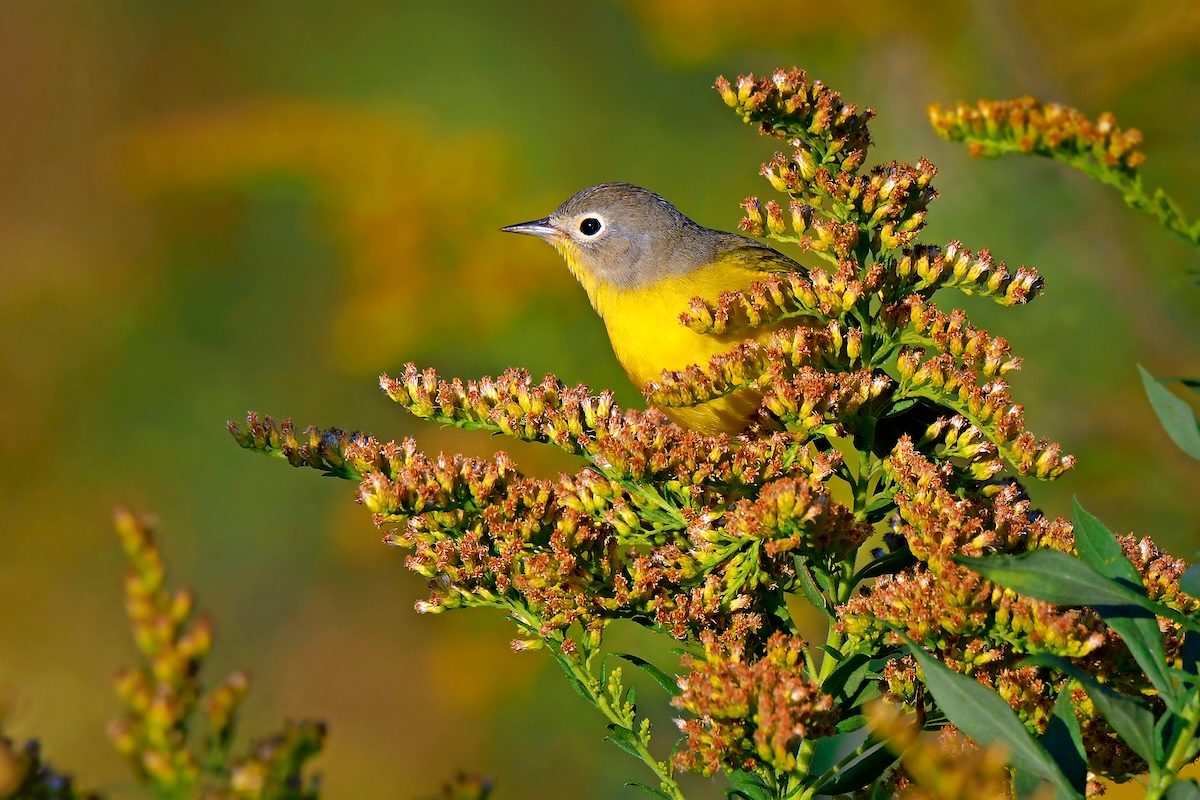Learn all about the brightly colored Nashville warbler, and where to look to find one. Plus, hear this teeny bird's cheery, chipper song.

Meet the Acrobatic Nashville Warbler

On This Page
How to Identify a Nashville Warbler

In general, a Nashville warbler’s most distinct marking is its white eye ring. Birders should be on the lookout for a gray head, as well as a striking yellow throat patch and yellow chest. While a Nashville warbler does technically have reddish-brown coloration on the crowns of its head, that can be tricky to spot. “I tell people to look for the overall coloration, the eye ring, and then the throat patch,” Whitney Yoerger, Communications and Outreach Coordinator for Indiana Audubon, says.”It’s hard to see that red mark on the crown.” Females and immature birds follow the same coloration pattern, but muted.
Unlike other warblers, the Nashville warbler’s plumage doesn’t undergo a major transformation in the fall. They remain easily identifiable during both spring and fall migration. With that in mind, the most difficult part of identifying a this bird might not be getting your I.D. right, but finding one at all.
“With a Nashville warbler, they’re pretty small,” Whitney says. “If you can put your binoculars up and get them on the bird quickly, that’s one of the biggest challenges.”
Nashville Warbler Range and Habitat

During spring migration, look for the quick, active Nashville warbler in thickets and small trees. That’s good news for birders who crane their neck attempting to spot more elusive warblers that spend time at the very tops of trees. “You can find a Nashville warbler up close in a shrub, or in the understory of a wooded area, or mid-height in a tree,” Whitney says. “There are opportunities to see them a lot closer than other species.”
These fast, brightly colored birds pass through the Midwest and portions of the eastern United States during migration, as well as coastal western states such as California. They stay for breeding season in sections of California, Oregon, Washington, and Idaho. In the East, they stick around in Vermont, New Hampshire, and Maine before undergoing fall migration back to their winter home in Central America.
What Does a Nashville Warbler Eat?

Nashville warblers eat insects such as caterpillars and grasshoppers, so they seldom come to bird feeders. However, you might be able to attract these birds with a birdbath, because migrating warblers are strongly drawn to water. “Even better, if you have some sort of moving water or a bubbler in your birdbath, that’s a great way to attract them because it allows them to drink and freshen up after their overnight migration,” Whitney says. “If you have native habitat in your yard, like coneflowers or tall grasses, that’s a good way to attract them as well.”
Nesting Habits

Despite its name, this warbler doesn’t nest in Tennessee. The species breeds much farther north in bogs and coniferous woods, among other habitats. Nests are built on the ground. Females lay a clutch of 4 to 5 eggs and do most of the incubation duties, although the males do assist. Young leave the nest less than two weeks after hatching.
Meet the majestic magnolia warbler.
Songs and Calls
Bird sounds courtesy of the Cornell Lab of Ornithology
To identify a Nashville warbler by ear, listen for a two-part call. The first part consists of high-pitched trilling, and the second slows and lowers in pitch. “If you’re looking for them in the springtime, you’re going to hear that, and in the fall you’ll hear contact calls,” Whitney says, referencing the calls the birds make to other birds as they migrate in flocks.
About the Expert
Outdoor enthusiast Whitney Yoerger is the communications and outreach manager for Indiana Audubon. Whitney is also a member of the board of the directors for the Indiana Wildlife Federation.
Sources
- National Audubon Society, “Field Guide: Nashville Warbler“
- Cornell Lab of Ornithology, “Nashville Warbler“
Next, learn how to identify a yellow warbler.




















